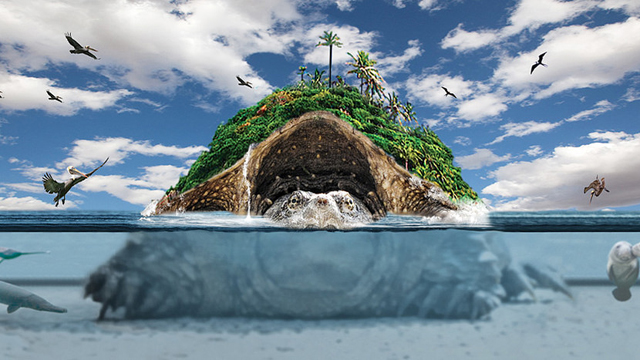 "Turtle island" artwork
"Turtle island" artwork
View more colorful photos of the experience on our Flickr page (Loss of Turtle Island album).
[/box]The Loss of Turtle Island was a poignant historical journey that opened the eyes, ears, minds and hearts of those who experienced it on Sunday evening, Nov. 12, at Innabah Camp & Retreat Center.
Sponsored by the Eastern PA Conference Committee on Native American Ministries (CONAM), the interactive exercise posed a striking scene, as about half of the 50 people who came stood shoeless on a patchwork of colorful blankets. They stood on behalf of Native peoples who have suffered loss of land, colonization, broken treaties, forced removal, assimilation and extermination. And facing forward, they silently listened as a team of CONAM facilitators recounted this largely unknown American history.
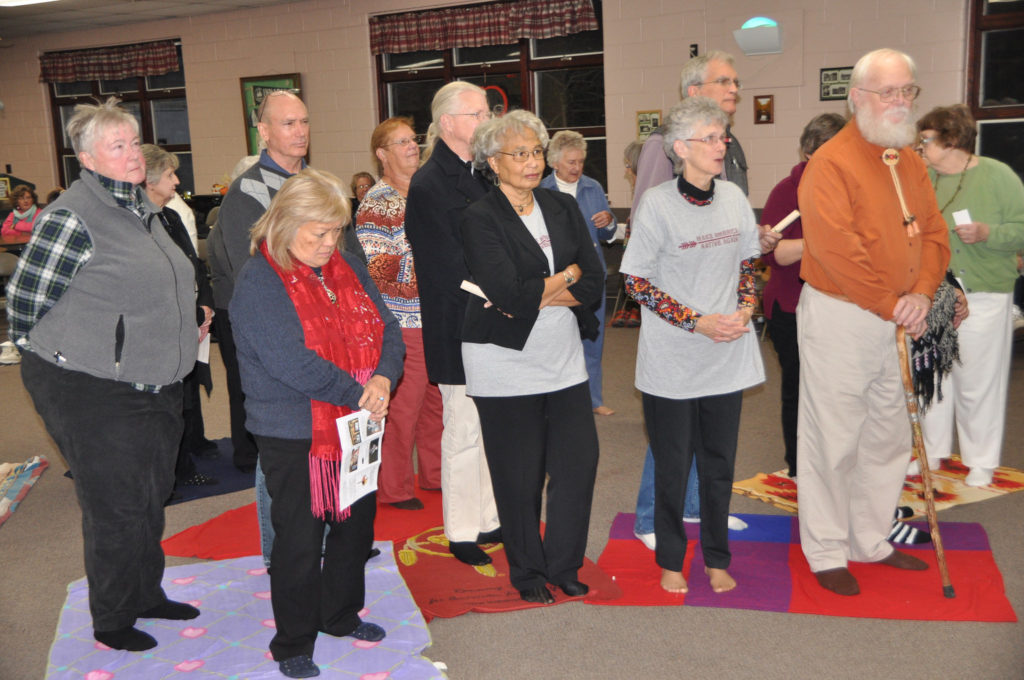
Encircling them was a large contingent of other witnesses, silent and seated, who also watched and listened intently. Their faces bore serious expressions as they heard troubling statements read. Periodically, individuals in each group would take turns reading statements themselves from small scrolls of parchment.
And periodically, facilitators would walk over to the standing witnesses and remove blankets from beneath their stockinged feet. This abrupt action symbolized the taking of land—parts of Turtle Island—from its original inhabitants and the removal of those inhabitants from lands that had long sheltered, nurtured and fed them.
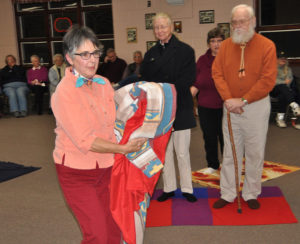 Once their blankets were taken, the standing witnesses would silently leave and sit alongside their peers. Their gradual disappearance from the floor continued until there were no more blankets and no more land upon which to stand.
Once their blankets were taken, the standing witnesses would silently leave and sit alongside their peers. Their gradual disappearance from the floor continued until there were no more blankets and no more land upon which to stand.
To see, to hear, to know, to feel
It was riveting to see this human exercise unfold. But to learn the stark truth underlying its disturbing symbolism required one to listen to the words being read, accompanied by visual slides on-screen. The words spoke of brutal violence, of heartless exploitation, of rampant conspiracy and cruel dehumanization, all inflicted on Native Americans by Europeans who came as invaders, conquerors, colonizers and land-grabbers, claiming white supremacy and America’s dubious manifest destiny.
The words spoke of suffering but survival, of capitulation but compromise, of forced removal but fierce resiliency. They were words of and about Native people who were here first but became last, who were pushed off their fertile lands and onto barren reservations, pushed into boarding schools for assimilation, pushed out of history books, except to appear as villains and caricatures, and finally pushed into the dim margins of America’s conscience—out of sight, out of mind.
The words and the history undergirding this solemn Loss of Turtle Island exercise were the real source of painful expressions around the room. That history includes the frequent complicity of Christian churches that accommodated or even conspired with various militaries and governments to promote immoral edicts like the malignant Doctrine of Discovery.
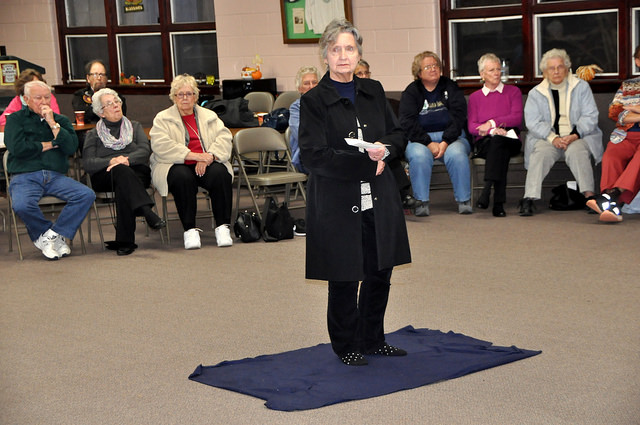
Doctrine of Discovery
The Mennonite Church, which studied and repudiated this antiquated doctrine, defines it as “a philosophical and legal framework dating back to the 15th century that gave Christian governments moral and legal rights to invade and seize Indigenous lands and dominate Indigenous Peoples.” The United Methodist Church denounced it in 2012 and again in 2016. (“Doctrine of Discovery,” 2016 Book of Resolutions, #3331)
Four Eastern PA CONAM leaders met with Mennonite leaders in May at their national offices in Akron, Pa., for a seminar to learn more about the Doctrine of Discovery. Although widely rejected, it is still used to support legal judgments related to property ownership and acquisition in U.S. courts. The CONAM leaders were trained to facilitate the Loss of Turtle Island exercise, which they led first at the Northeastern Jurisdictional CONAM meeting in Maine in October.
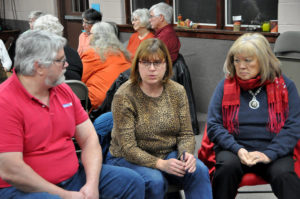 The exercise at Innabah was followed by dialogue, as leaders and participants formed four talking circles and took turns sharing their observations, reactions, concerns, personal experiences and learned insights. Participants, including several Native American church members and guests, came from across the conference. Nine came from Summerfield-Siloam UMC in the Kensington area of Philadelphia, which has a longtime relationship with the Ponca Indian Mission in Oklahoma.
The exercise at Innabah was followed by dialogue, as leaders and participants formed four talking circles and took turns sharing their observations, reactions, concerns, personal experiences and learned insights. Participants, including several Native American church members and guests, came from across the conference. Nine came from Summerfield-Siloam UMC in the Kensington area of Philadelphia, which has a longtime relationship with the Ponca Indian Mission in Oklahoma.
“I was pleased to see so much truth up there and that the story of Indians being robbed of their land and rights was so well presented,” said Bob, a well-informed Summerfield-Siloam member. “But it makes me angry. Some laws and treaties may have been written by men of goodwill, but there was so much duplicity.”
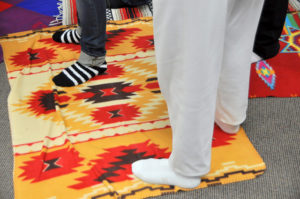 ‘We live on stolen land’
‘We live on stolen land’
“It seemed to me that most people found themselves identifying with the Native Americans and were not able to understand the actions of the colonists,” recalled the Rev. Gary Jacabella, pastor of Exton UMC and a CONAM member. “I think most people felt at a loss to say how to right these wrongs or what to do about the way so many of us benefit from these wrongs today. We live on stolen land.”
“I cried when I learned about the Trail of Tears at (UMW) School of Mission,” said Joy Frazier, Scottsville UMC’s representative to CONAM. “I knew some of this history, but there was so much here that I didn’t know.”
CONAM member Verna Colliver said she sensed “anguish of Native Americans in the group exercise, while non-Native persons expressed sadness, pain, guilt and even anger. As a non-Native I ask myself ‘How could such cruelty happen?’ Then I realize it’s still happening, and I ask ‘What am I going to do about it?’”
“This exercise of participating in the historical overview of our country’s abuse of Indigenous people was sobering,” said Bishop Peggy Johnson, who wore a t-shirt given to her that read, “Make America Native Again.” “Yet it brought with it a thread of hope for a future when people who have learned the stories can create a new and just day in the future. We need to be students of history in order to walk in the right direction going forward.”
[box]View more colorful photos of the experience on our Flickr page (Loss of Turtle Island album).
[/box]Additional comments by Eastern PA Conference CONAM members in reaction to the Loss of Turtle Island exercise and dialogues.
Verna Colliver:
What comes to me as I reflect on the talking circle as well as comments during the exercise is hearing and sensing the emotion and anguish of Native Americans in the group exercise on the one hand and on the other hand, the non-native persons expressing a mixture of sadness, pain, guilt and even anger. As a non-native I ask myself “How could such cruelty happen?” Then I realize it’s still happening and ask “What am I going to do about it?”
“A nurse in our group was especially upset by the way disease was spread through the exchange of blankets. Because she is a healer she could not comprehend people doing this to each other. One member of the group reminded us that this way of spreading disease started back with the early Spanish explorers in South and Central America.”
Barbara Christy Lee:
One person in my group was so very torn in her thoughts. She felt that her ancestors and the colonists had committed such crimes against the native people. Then after that statement she felt that there was nothing else that could have been done by the ancestors/colonists to alleviate the issues that were happening at the time. I told her I would call it a “Clash of Cultures”. Lack of understanding the ways/culture of each other created a total lack of understanding between them. Lack of communication due to language also did not help the situation. Tensions caused between them due to lack of understanding, empathy, & compassion led to warfare, senseless murder, retribution by all involved, etc. Add greed to the mix.
Gary Jacabella:
One member of our group was confused by the way Christian faith got mixed up in these horrors in a negative way. It was hard for her to take in how something good, sharing Jesus, became something bad.
I was surprised that some of the early statements coming out of the American colonies were actually positive and spelled out the possibility of Natives and Europeans existing side by side as equal cooperating nations. To me this takes away the excuse that the early colonists were ignorant. All along there were prophetic voices showing another way so that those who were involved in genocide have no excuse. They were offered peaceful humane alternatives of living together.
Tears come to my eyes whenever we talk about the children buried at Carlisle and the process of taking their remains home. So sad to think of children taken from home and laid to rest in a foreign land. Taking their remains home now is so little so late.
One member of the group was very frustrated by how the true history of what happened has been avoided and not taught especially in schools to our children. We heard a lot of information on Sunday but it really wasn’t that hard to tell the truth even though it was hard to hear.
It seemed to me that most people found themselves identifying with the Native Americans and were not able to understand the actions of the colonists. I think most people felt at a loss to say how to right these wrongs or what to do about the way so many of us benefit from these wrongs today. We live on stolen land.
It was emphasized in our group that the wrongs are not all in the past. Systems that do harm are still in place today. Especially now as Thanksgiving approaches, children are being told lies about what really happened between the pilgrims and the Native Americans.
“I love Pennsylvania and it’s such a beautiful place. But I can’t get away from realizing that we are living on stolen land.” (Gary)
Sandra Cianciulli:
Resembles statements from our group as well. What gets me emotional everytime I see this exercise is the jaw-dropping expressions from good people who are learning about the systematic genocide deliberately designed by our “founding fathers”. This is not just “history”, there are still attacks on Tribal sovereignty.
Another point made in our group was people wondering what they could do. PA hasn’t had guidelines on teaching anything about Native Americans for too many years. Maybe we could making that an issue?
I don’t think I’ve said anything quotable but just want our committee to think about maybe creating a series of exercises that reflect more contemporary legislation and Supreme Court decisions that set out to harm Indian Country,
I was overwhelmed with emotion to witnessing such heartfelt responses to this long-ignored issue. It was inspiring!
Sherry Wack:
We are hoping to do this again. Perhaps with the youth? We would do it for any group between 20 – 50 people.
As to reparations, it is a very thorny issue which nonetheless needs to be addressed. Honoring treaties would be a good start. In our group I suggested contributing to a Native American cause such as Honor the Earth or Running Strong for American Indian Youth. Going on a mission trip to Calvin Hill’s BUMP mission in Montana.
I asked, “What is the next step after the Act of Repentance?” And we thought the one thing we can do is raise awareness of the harm that continues to be done in violating the rights of Native Americans. We suggested searching out news about Native issues.
